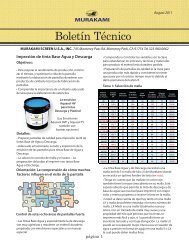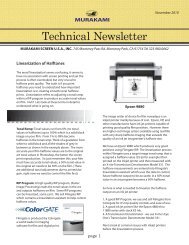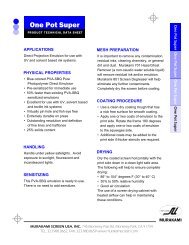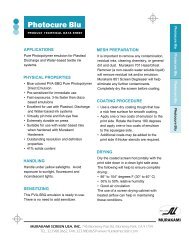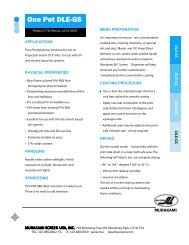Thin Thread Print Applications pg 1 - Murakami Screen
Thin Thread Print Applications pg 1 - Murakami Screen
Thin Thread Print Applications pg 1 - Murakami Screen
Create successful ePaper yourself
Turn your PDF publications into a flip-book with our unique Google optimized e-Paper software.
MURAKAMI SCREEN U.S.A., INC. 745 Monterey Pass Rd. Monterey Park, CA 91754 Tel 323.980.0662<br />
Using <strong>Thin</strong> <strong>Thread</strong> Mesh<br />
Discharge Ink:<br />
Discharge <strong>Print</strong>s are more vibrant and have greater<br />
details using the proper thin thread mesh. S-thread<br />
mesh allows the ink to pass with ease through a<br />
greater open area than is achievable with T thread<br />
mesh. Typically to get good discharge color the print<br />
must soak the shirt 50% of the way through the<br />
fabric so that during<br />
curing the surface<br />
fabric and underlying<br />
weave is completely<br />
discharged to a<br />
greige goods color.<br />
Generally the greige<br />
goods color is a tan<br />
color. Dierent<br />
colors of fabric have dierent discharge ratings, 5<br />
being best and 1 being marginal. A black shirt is<br />
typically a “5” while a turquoise shirt made with<br />
dischargable reactive dyes does not discharge as well<br />
and is rated at 1-2 on discharge eectiveness.<br />
The examples shown here were printed at Motion<br />
Graphics in Sacramento California. Tom has a great<br />
article coming out in the June issue of <strong>Print</strong>wear<br />
magazine that deserves reading.<br />
Look at the detail below in this discharge print. S<br />
thread allowed lots of discharge ink to pass through<br />
the mesh, in this case a 150 thread per inch with a 48<br />
micron thread. In the past this would be classied as<br />
an S thread. Today with the<br />
variety of thread sizes<br />
available we refer to it as a<br />
150/48. When S <strong>Thread</strong> is<br />
combined with Aquasol HV<br />
or HVP the screen has the<br />
best combination for<br />
printing discharge. S-thread<br />
helps the ink print well, and<br />
Aquasol HV or HVP can<br />
stand up to the longest<br />
print runs you can produce.<br />
MURAKAMI<br />
Technical Newsletter<br />
page 1<br />
May 2010<br />
However there are many dierent fabric weights and<br />
weaves that require specic mesh counts to achieve<br />
brilliant detailed discharge. Typically shirts have<br />
dierent fabric weights from very light 4.3 oz up to 6.1<br />
oz ‘Beefy T’ weights as well as dierent thicknesses of<br />
yarn and singles count. The chart below are fabric<br />
weights and the highest mesh count suggestion that<br />
can be used. Press set up can have many more<br />
adjustments to yield a good print. Squeegee angle,<br />
durometer and speed also play an important part of a<br />
good print. S thread can eliminate some of these<br />
adjustments so that press settings of the squeegees<br />
do not need minimal modication.<br />
Shirt Fabric Weight 4.3 4.8 5.6 6.1 2x1 Rib<br />
Suggested S Mesh Size 225/40 150/48 110/71 110/71 80/71<br />
To obtain the detail of the example shown you need<br />
S-<strong>Thread</strong>. The increased open area allows the ink to<br />
soak the shirt while the higher mesh counts improves<br />
the detail the screen is capable of printing. The mesh<br />
statistics in the chart below shows why. 150-48 has an<br />
open area of 51% but has 40 more threads per inch<br />
than a 110-T mesh which only has a 43% open area.<br />
So more threads and more open area all create a<br />
sharper discharge print with excellent color.<br />
150-S and 110-T Comparison 110-T 150-S<br />
Plastisol Ink:<br />
225-S 150-S 110-S 110-S 80-S<br />
<strong>Thread</strong> Thickness in Microns 80 48<br />
Mesh Thickness in Microns 134 77<br />
Mesh Opening Size in Microns 151 121<br />
Percentage of Open Area 48% 51%<br />
S thread is the best improvement you can make for<br />
your base plates. A 150-S can print brighter and more<br />
detailed base plates than a 110-T typically used on<br />
most plastisol base plate printing. Just like discharge,<br />
base plates made with 150/48 can hold more detail,<br />
and in the case of plastisol, use much less squeegee<br />
pressure resulting in a softer hand print since the ink is<br />
laid on the surface of the shirt and not driven into the<br />
fabric. As a bonus 150/48 uses less ink than a 110T.
MURAKAMI<br />
Technical Newsletter<br />
May 2010<br />
MURAKAMI SCREEN U.S.A., INC. 745 Monterey Pass Rd. Monterey Park, CA 91754 Tel 323.980.0662<br />
The examples below show the results obtainable with<br />
S thread mesh using plastisol inks. <strong>Print</strong>ing on base<br />
plates is also easier with S-thread mesh. The color<br />
plates are typically in the 225 to 350 range depending<br />
on halftone counts, area needed to be covered with<br />
ink and the ink color viscosity. The key is less squeegee<br />
pressure. Less pressure is needed to transfer the<br />
ink to the print which preserves details in the design<br />
from being smeared with too much squeegee<br />
pressure. The negative space of tonal areas in the<br />
60-80% range are better preserved.<br />
Shirt Courtesy of Ink Throwers<br />
Tijuana, Baja California<br />
© Ink Throwers<br />
A print like the one above and the tatoo woman on<br />
the opposite page with almost a solid base plate are<br />
much more commercially viable with a softhand feel.<br />
Too often we modify inks, soften them, thin them out<br />
add soft hand extenders when all that is needed is a<br />
better mesh like 150/48.<br />
(A special thanks to Motion Textile and to Ink Throwers<br />
for sharing their outstanding art work and printing for<br />
this article.)<br />
page 2<br />
Shirt Courtesy of Motion Textiles<br />
Sacramento, California<br />
© Motion Textiles<br />
In many cases, as seen in the photo below, a base<br />
plate may not be necessary since the ink sits on the<br />
surface of the shirt and not beneath it. The lack of a<br />
base plate signicantly improves the urban grunge<br />
texture look prevalent in many designs being created<br />
for today’s market’s. Eliminating base plates saves on<br />
ink, increases production yields due to faster ashing<br />
of thinner or smaller print areas in designs like this.<br />
Shirt Courtesy of Motion Textiles<br />
Sacramento, California<br />
© Motion Textiles
MURAKAMI<br />
Technical Newsletter<br />
May 2010<br />
MURAKAMI SCREEN U.S.A., INC. 745 Monterey Pass Rd. Monterey Park, CA 91754 Tel 323.980.0662<br />
<strong>Murakami</strong> <strong>Screen</strong> USA now oers pre-stretched frames in S-<strong>Thread</strong> as well as conventional<br />
threads and in bolts. Call today to reserve your order of the best screen mesh. Seeing is believing!<br />
page 3



